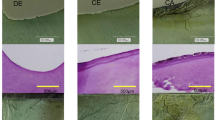The results of sound and carious enamel fl uorescence emission study using (i) different blue wavelengths, (ii) different scan velocity, and (iii) spectral ratio are reported. The samples were irradiated using a tunable argon laser emitting at 459 and 488 nm and a 405 nm laser at two different scan velocities of 0.23 and 0.5 mm/s. The results showed a spectral band of 443–492 nm for 405 nm, 493–522 nm for 459 nm, and 526–625 nm for 488 nm lasers for sound teeth. It was found from the emission spectra that with increase in the excitation wavelength, the corresponding primary peaks of the carious samples showed Stokes shifts of 4, 6, and 2 nm, respectively. No signifi cant change was observed for the secondary peaks. Also, in all cases, the intensity of fl uorescence signals of sound teeth was higher than those of carious teeth. The highest shape factor of 1.82 and integrated intensity ratio of 1.20 were achieved at 405 nm, which provides relatively better tissue discrimination. Also, increasing the scan velocity reduced the signal amplitudes in both sound and carious samples.
Similar content being viewed by others
References
Y. Hosoya, T. Taguchi, and F. Tay, J. Dent., 35, 137–143 (2007).
C. Ketley and R. Holt, Br. Dent. J., 174, 364–370 (1993).
M. E. Khosroshahi and A. Ghasemi, Laser Med. Sci., 18, 196–203 (2004).
R. Thareja, A. Sharma, and S. Shukla, Med. Eng. Phys., 30, 1143–1148 (2008).
M. Neimz, Proc. SPIE, 2323, 170–179 (1994).
A. Ko, M. Hewko, and M. Sowa, Opt. Express, 16, 6274–6279 (2008).
A. Schneiderman, M. Elbaun, and T. Shultz, Caries Res., 31, 103–107 (1997).
D. Popesca, M. Sowa, and M. Hewko, J. Biomed. Opt., 13, 054053 (2008).
Y. Kimura, P. Wilder, and T. Krasiova, A. Anna Maria, Proc. SPIE, 2672, 64–72 (1996).
C. Rousseau, S.Poland, and J. Girkin, Caries Res., 41, 245–251 (2007).
A. Hall,E. Deschepper, and M. Ando, Adv. Dent. Res., 11, 507–514 (1997).
B. T. Amaechi and S. Higham, Proc. SPIE, 4432, 110–117 (2001).
R. Jeon, A. Hellen, A. Matveinko, A. Mandelis, and A. Abram, Caries Res., 41, 323–332 (2007).
A. Hellen, A. Mandelis ,Y. Finer, and B. T. Amaechi, J. Biomed. Opt., 16, 1–13(2011).
M. Gadalla and M. El Sharkawi, J. Med. Biol. Eng., 30, 113–118 (2010).
C. L. Darling, J. Jiao, C. Lee, and H. Kang, Proc. SPIE, 7549, 75490 L (2010).
R. Hibst, R. Papulus, and A. Lussi, Med. Laser Appl., 16, 205–213 (2001).
A. Boltzan de Paula, and J. D. Campos, M. Dinizi, J. Hebling, Laser Med. Sci., 26, 1–5 (2011).
E. Shhly, S. Brailsford, and E. Kidd, Caries Res., 35, 421–426 (2001).
K. Konig and H. Schneckenburger, J. Fluores., 4, 17–40 (1994).
S. Abrams, Restor. Dent., 12, 10–16 (2009).
A. Banerjee and A. Boyde, Caries Res., 32, 219–226 (1997).
E. Borisova, T. Uzunov, and L. Avramov, Laser Surg. Med., 34, 249–253 (2004).
E. Borisova, T. Uzunov, and L. Avramov, Laser Med. Sci., 21, 34–41 (2006).
P. Gupta, S. K. Majumder, and A. Uppel, Laser Surg. Med., 21, 417–422 (1997).
M. E. Khosroshahi and M. Rahmani, J. Fluores., 22, 281–288 (2012).
R. Alfano and S. Yao, J. Dent. Res., 60,120–122 (1981).
Q. Fang, T. Papaioannou, A.Javier, and J. Vaitha, Rew. Sci. Instrum.,75, 151–162 (2004)
M. Kazuba, G. Liszk, H. Trazeciak, and Z. Drazaga, Pol. J. Environ. Stud., 15, 151–153 (2006).
A. Riberio, C. Rousseau, J. Girkin, and A. Hall, J. Dent., 33, 73–78 (2005).
Q. Chen, B. Lin, Z. Chen, and H. Zhu, Laser Phys., 7, 752–756 (2010).
N. Subhash, Sh. Thmas, R. Maldia, and M. Jose, Laser Surg. Med., 37, 320–328 (2005).
Z. Drzazga, G. Liszka, and A. Kluczewska, Proc. Photon. Tech., Wroclow, 295–298 (2006).
F. Sundstrom, K. Fredriksson, and S. Montan, J. Swed. Dent., 9, 71–80 (1985).
S. Albein, C. Byvik, and A. Buoncristiani, Laser Surg., 907, 96–99 (1988).
A. Gomes, D. M. Zezzel, A. Ribeiro, and I. Bachmann, J. Biomed. Opt., 12, 064013 (2007).
G. A. Zalesskaya and T. O. Maslova, J. Appl. Spectrosc., 77, 547–581 (2010).
Author information
Authors and Affiliations
Corresponding author
Additional information
Abstract of article is published in Zhurnal Prikladnoi Spektroskopii, Vol. 81, No. 2, p. 328, March–April, 2014.
Rights and permissions
About this article
Cite this article
Khosroshahi, M.E., Khoi, N.T. Comparison of Blue Wavelengths and Scan Velocity Effects on the Detection of Enamel Surface Caries Using Steady-State Laser-Induced Autofluorescence Spectroscopy. J Appl Spectrosc 81, 347–354 (2014). https://doi.org/10.1007/s10812-014-9935-4
Published:
Issue Date:
DOI: https://doi.org/10.1007/s10812-014-9935-4




